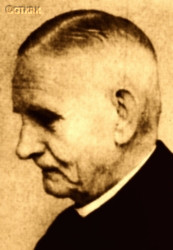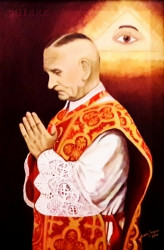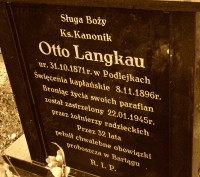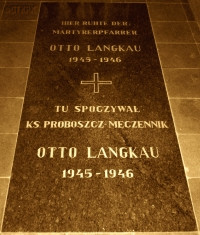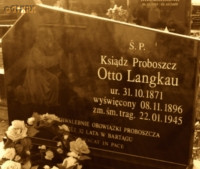Roman Catholic
St Sigismund parish
05-507 Słomczyn
85 Wiślana Str.
Konstancin deanery
Warsaw archdiocese, Poland
full list:
displayClick to display full list

searchClick to search full list by categories
wyświetlKliknij by wyświetlić pełną listę po polsku

szukajKliknij by przeszukać listę wg kategorii po polsku

Martyrology of the clergy — Poland
XX century (1914 – 1989)
personal data
religious status
Servant of God
surname
LANGKAU
forename(s)
Otto (pl. Otton)
forename(s)
versions/aliases
Otto
function
diocesan priest
creed
Latin (Roman Catholic) Church RCmore on
en.wikipedia.org
[access: 2014.09.21]
diocese / province
Warmia diocesemore on
en.wikipedia.org
[access: 2018.09.02]
honorary titles
Ad Honores Spiritual Counselormore on
Ad Honores Spiritual Counselor
date and place
of death
22.01.1945

Bartągtoday: Stawiguda gm., Olsztyn pov., Warmia‐Masuria voiv., Poland
more on
en.wikipedia.org
[access: 2022.02.14]
details of death
During the final Russian push of the World War II — started by German and Russian invasion of Poland in 09.1939 — in 01.1945 in East Prussia Russians barged into the rectory, where in the basement he was hiding together with hew vicar and nephew, Fr Paul Langkau, and his sister, among others.
Put fire to the shed.
Knocked on the door and when he opened it Russian soldier shot him dead — twice into the heart — and tossed a grenade at him that did not explode though.
cause of death
murder
perpetrators
Russians
sites and events
Ribbentrop‐MolotovClick to display the description, Pius XI's encyclicalsClick to display the description
date and place
of birth
30.10.1871

Polejkitoday: Jonkowo gm., Olsztyn pov., Warmia‐Masuria voiv., Poland
more on
en.wikipedia.org
[access: 2022.01.28]
alt. dates and places
of birth
31.10.1871
Podlejkitoday: Gietrzwałd gm., Olsztyn pov., Warmia‐Masuria voiv., Poland
more on
en.wikipedia.org
[access: 2022.01.28]
presbyter (holy orders)
ordination
08.11.1896

Fromborktoday: Frombork gm., Braniewo pov., Warmia‐Masuria voiv., Poland
more on
en.wikipedia.org
[access: 2022.01.28]
Assumption of the Blessed Virgin Mary and St Andrew the Apostle RC cathedral churchmore on
en.wikipedia.org
[access: 2025.03.14]
positions held
1940 – 1945
deputy dean — Olsztyntoday: Olsztyn city pov., Warmia‐Masuria voiv., Poland
more on
en.wikipedia.org
[access: 2022.01.28] RC deanery
1913 – 1945
parish priest — Bartągtoday: Stawiguda gm., Olsztyn pov., Warmia‐Masuria voiv., Poland
more on
en.wikipedia.org
[access: 2022.02.14] ⋄ St John the Evangelist RC parish ⋄ Olsztyntoday: Olsztyn city pov., Warmia‐Masuria voiv., Poland
more on
en.wikipedia.org
[access: 2022.01.28] RC deanery
1901 – 1913
parish priest — Lesiny Wielkietoday: Wielbark gm., Szczytno pov., Warmia‐Masuria voiv., Poland
more on
en.wikipedia.org
[access: 2021.12.18] ⋄ Immaculate Conception of the Blessed Virgin Mary RC parish ⋄ Mazurien Ideanery name
today: Warmia‐Masuria voiv., Poland RC deanery
1899 – 1901
administrator — Lesiny Wielkietoday: Wielbark gm., Szczytno pov., Warmia‐Masuria voiv., Poland
more on
en.wikipedia.org
[access: 2021.12.18] ⋄ Immaculate Conception of the Blessed Virgin Mary RC parish ⋄ Mazurien Ideanery name
today: Warmia‐Masuria voiv., Poland RC deanery
1898 – 1899
vicar — Biskupiecalso: Biskupiec Reszelski
today: Biskupiec gm., Olsztyn pov., Warmia‐Masuria voiv., Poland
more on
en.wikipedia.org
[access: 2022.02.14] ⋄ St John the Baptist RC parish ⋄ Jezioranytoday: Jeziorany gm., Olsztyn pov., Warmia‐Masuria voiv., Poland
more on
en.wikipedia.org
[access: 2022.01.28] RC deanery
1897 – 1898
vicar — Bisztynektoday: Bisztynek gm., Bartoszyce pov., Warmia‐Masuria voiv., Poland
more on
en.wikipedia.org
[access: 2021.10.09] ⋄ St Matthias the Apostle and Holiest Blood of Jesus Christ RC parish ⋄ Reszeltoday: Reszel gm., Kętrzyn pov., Warmia‐Masuria voiv., Poland
more on
en.wikipedia.org
[access: 2022.01.28] RC deanery
1896 – 1897
vicar — Sztumtoday: Sztum gm., Sztum pov., Pomerania voiv., Poland
more on
en.wikipedia.org
[access: 2022.01.28] ⋄ St Anne RC parish ⋄ Sztumtoday: Sztum gm., Sztum pov., Pomerania voiv., Poland
more on
en.wikipedia.org
[access: 2022.01.28] RC deanery
till 1896
student — Braniewotoday: Braniewo urban gm., Braniewo pov., Warmia‐Masuria voiv., Poland
more on
en.wikipedia.org
[access: 2022.02.14] ⋄ philosophy and theology, Theological Seminary
others related
in death
BEHRENDTClick to display biography Joseph, LANGKAUClick to display biography Paul, BREHMClick to display biography William, CHMIELEWSKIClick to display biography John Paul, FUCHSClick to display biography Godfrey, HUHNClick to display biography Paul, KLEMENTClick to display biography Bernard, KORTENDIECKClick to display biography Theodore, LINDENBLATTClick to display biography John, LINKAClick to display biography Arthur, LUDWIGClick to display biography Francis, LUNKWITZClick to display biography Paul, MARQUARDTClick to display biography John, PREUSCHOFFClick to display biography Clement, PROTHMANNClick to display biography Adalbert, RAHMELClick to display biography Engelbert, SCHIKOWSKIClick to display biography Ulrich, SCHULZClick to display biography Arthur, SCHWARTZClick to display biography Paul, SIEGELClick to display biography Bruno Alexander, STEINKIClick to display biography Joseph, ŚWITALSKIClick to display biography Vladislav Bronislav, WEICHSELClick to display biography Bruno, WILKEClick to display biography George, ZAGERMANNClick to display biography Francis, ZIEMETZKIClick to display biography Joachim
sites and events
descriptions
Ribbentrop‐Molotov: Genocidal Russian‐German alliance pact between Russian leader Joseph Stalin and German leader Adolf Hitler signed on 23.08.1939 in Moscow by respective foreign ministers, Mr. Vyacheslav Molotov for Russia and Joachim von Ribbentrop for Germany. The pact sanctioned and was the direct cause of joint Russian and German invasion of Poland and the outbreak of the World War II in 09.1939. In a political sense, the pact was an attempt to restore the status quo ante before 1914, with one exception, namely the „commercial” exchange of the so‐called „Kingdom of Poland”, which in 1914 was part of the Russian Empire, fore Eastern Galicia (today's western Ukraine), in 1914 belonging to the Austro‐Hungarian Empire. Galicia, including Lviv, was to be taken over by the Russians, the „Kingdom of Poland” — under the name of the General Governorate — Germany. The resultant „war was one of the greatest calamities and dramas of humanity in history, for two atheistic and anti‐Christian ideologies — national and international socialism — rejected God and His fifth Decalogue commandment: Thou shall not kill!” (Abp Stanislav Gądecki, 01.09.2019). The decisions taken — backed up by the betrayal of the formal allies of Poland, France and Germany, which on 12.09.1939, at a joint conference in Abbeville, decided not to provide aid to attacked Poland and not to take military action against Germany (a clear breach of treaty obligations with Poland) — were on 28.09.1939 slightly altered and made more precise when a treaty on „German‐Russian boundaries and friendship” was agreed by the same murderous signatories. One of its findings was establishment of spheres of influence in Central and Eastern Europe and in consequence IV partition of Poland. In one of its secret annexes agreed, that: „the Signatories will not tolerate on its respective territories any Polish propaganda that affects the territory of the other Side. On their respective territories they will suppress all such propaganda and inform each other of the measures taken to accomplish it”. The agreements resulted in a series of meeting between two genocidal organization representing both sides — German Gestapo and Russian NKVD when coordination of efforts to exterminate Polish intelligentsia and Polish leading classes (in Germany called «Intelligenzaktion», in Russia took the form of Katyń massacres) where discussed. Resulted in deaths of hundreds of thousands of Polish intelligentsia, including thousands of priests presented here, and tens of millions of ordinary people,. The results of this Russian‐German pact lasted till 1989 and are still in evidence even today. (more on: en.wikipedia.orgClick to attempt to display webpage
[access: 2015.09.30])
Pius XI's encyclicals: Facing the creation of two totalitarian systems in Europe, which seemed to compete with each other, though there were more similarities than contradictions between them, Pope Pius XI issued in 03.1937 (within 5 days) two encyclicals. In the „Mit brennender Sorge” (Eng. „With Burning Concern”) published on 14.03.1938, condemned the national socialism prevailing in Germany. The Pope wrote: „Whoever, following the old Germanic‐pre‐Christian beliefs, puts various impersonal fate in the place of a personal God, denies the wisdom of God and Providence […], whoever exalts earthly values: race or nation, or state, or state system, representatives of state power or other fundamental values of human society, […] and makes them the highest standard of all values, including religious ones, and idolizes them, this one […] is far from true faith in God and from a worldview corresponding to such faith”. On 19.03.1937, published „Divini Redemptoris” (Eng. „Divine Redeemer”), in which criticized Russian communism, dialectical materialism and the class struggle theory. The Pope wrote: „Communism deprives man of freedom, and therefore the spiritual basis of all life norms. It deprives the human person of all his dignity and any moral support with which he could resist the onslaught of blind passions […] This is the new gospel that Bolshevik and godless communism preaches as a message of salvation and redemption of humanity”… Pius XI demanded that the established human law be subjected to the natural law of God , recommended the implementation of the ideal of a Christian state and society, and called on Catholics to resist. Two years later, National Socialist Germany and Communist Russia came together and started World War II. (more on: www.vatican.vaClick to attempt to display webpage
[access: 2023.05.28], www.vatican.vaClick to attempt to display webpage
[access: 2023.05.28])
sources
personal:
ekai.plClick to attempt to display webpage
[access: 2012.11.23], pl.wikipedia.orgClick to attempt to display webpage
[access: 2013.05.19]
original images:
olsztyn.gosc.plClick to attempt to display webpage
[access: 2014.11.28], www.mogily.plClick to attempt to display webpage
[access: 2018.05.06], commons.wikimedia.orgClick to attempt to display webpage
[access: 2014.11.28], mojemazury.plClick to attempt to display webpage
[access: 2014.11.28]
LETTER to CUSTODIAN/ADMINISTRATOR
If you have an Email client on your communicator/computer — such as Mozilla Thunderbird, Windows Mail or Microsoft Outlook, described at WikipediaPatrz:
en.wikipedia.org, among others — try the link below, please:
LETTER to CUSTODIAN/ADMINISTRATORClick and try to call your own Email client
If however you do not run such a client or the above link is not active please send an email to the Custodian/Administrator using your account — in your customary email/correspondence engine — at the following address:

giving the following as the subject:
MARTYROLOGY: LANGKAU Otto
To return to the biography press below:
 Click to return to biography
Click to return to biography








